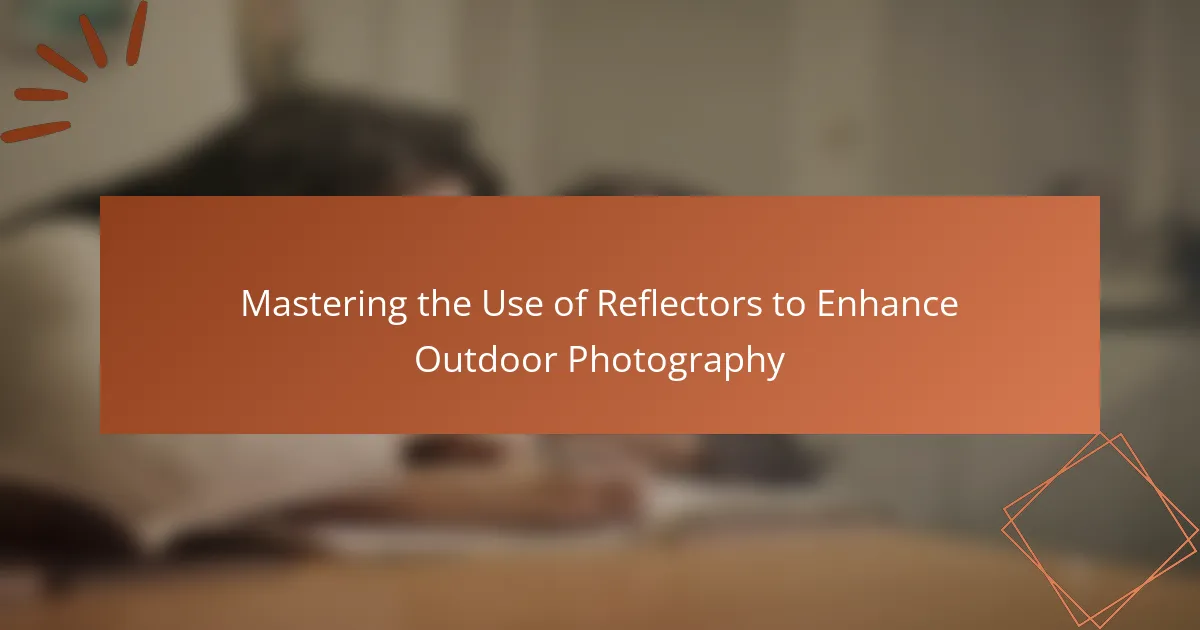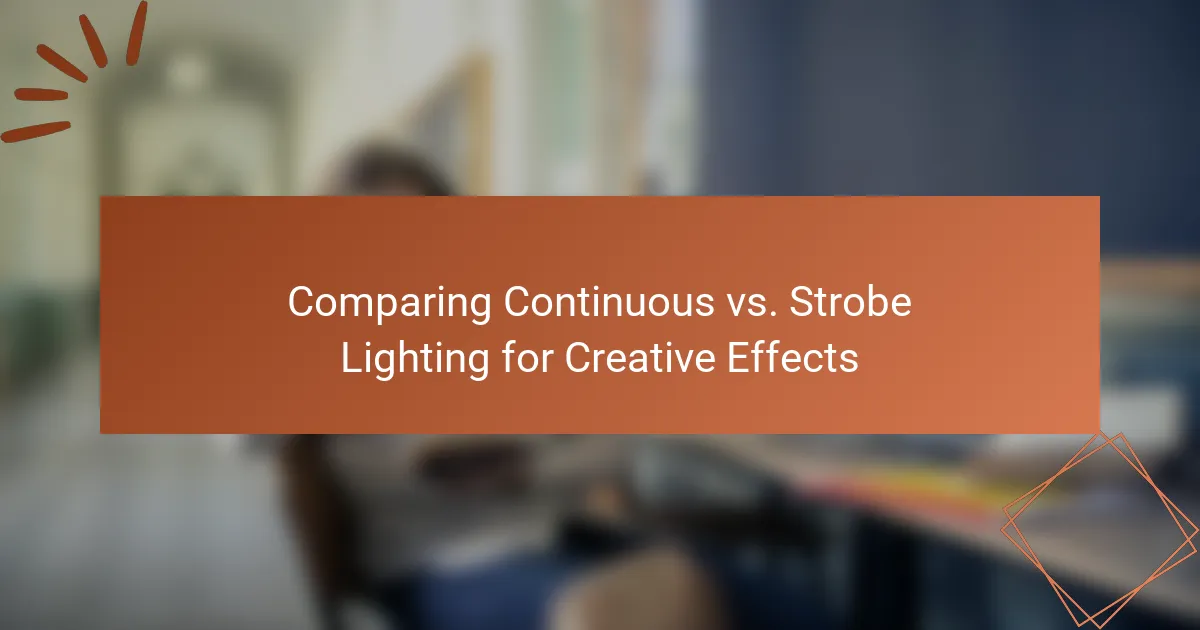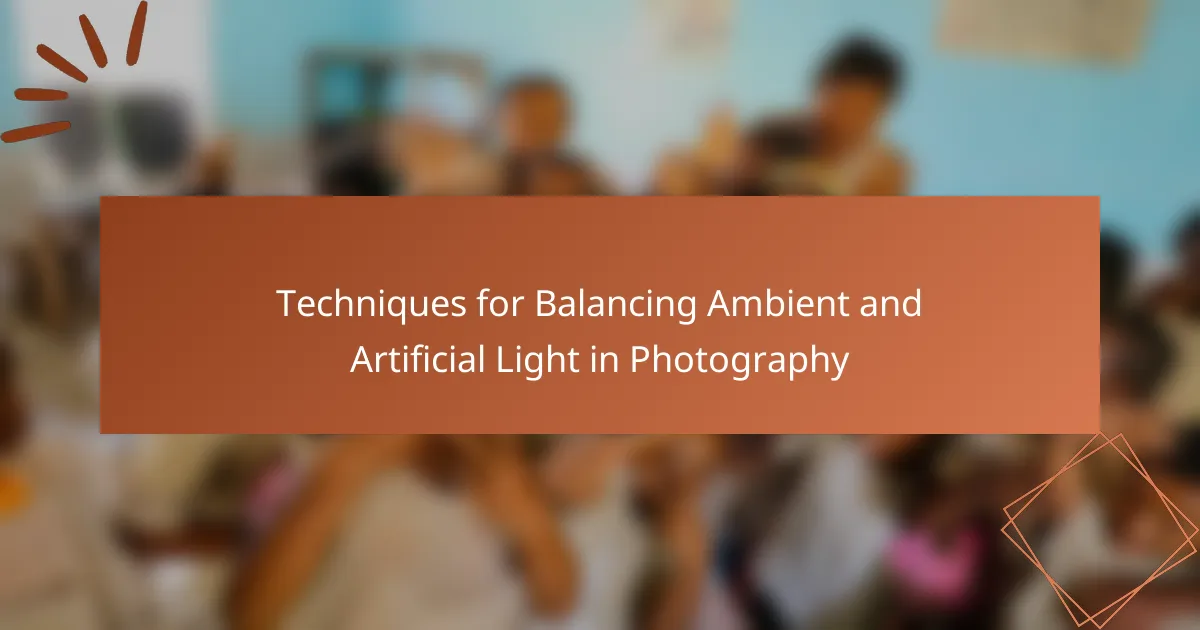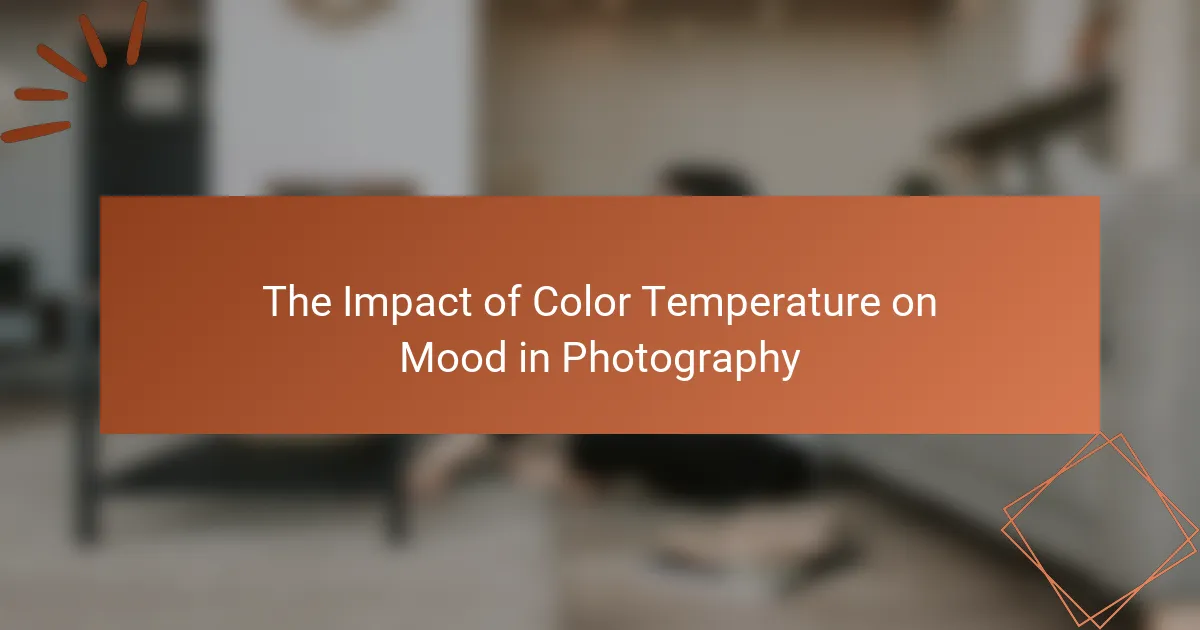Lighting ratios in studio photography define the relationship between key light and fill light, significantly influencing shadow creation and the three-dimensional appearance of subjects. Common ratios such as 1:1, 2:1, 3:1, and 4:1 dictate how light is distributed, affecting mood and texture in images. This article examines the various lighting ratios, their effects on composition, and common mistakes photographers make, including improper ratio settings and neglecting background considerations. Understanding and mastering these lighting ratios is essential for enhancing the visual impact of photographs.
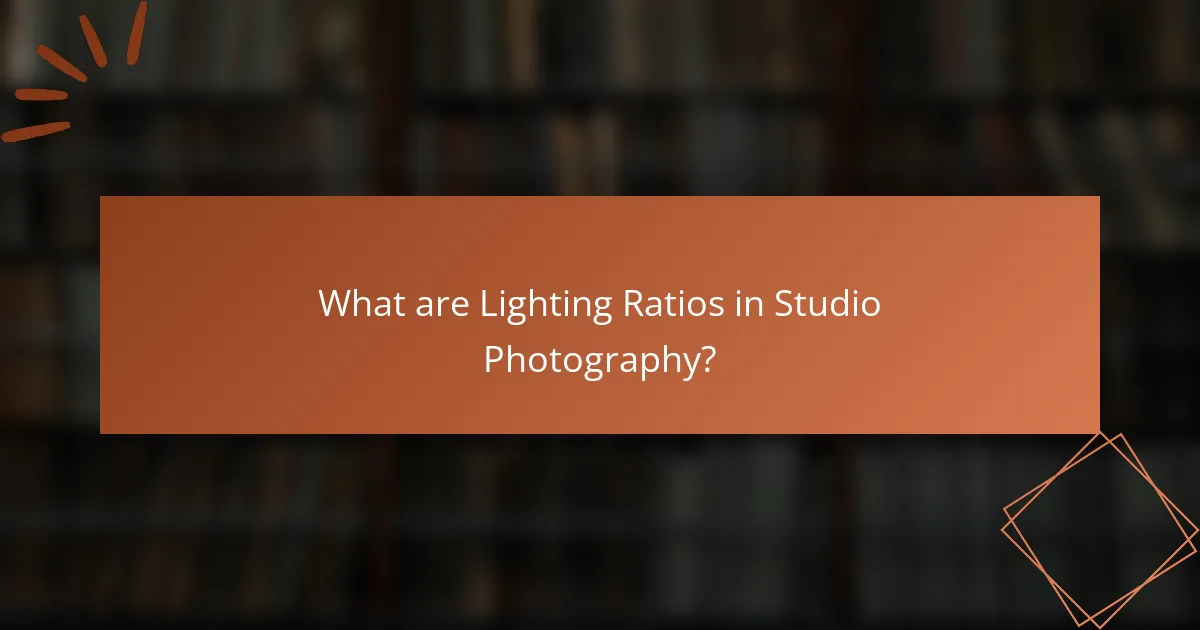
What are Lighting Ratios in Studio Photography?
Lighting ratios in studio photography refer to the relationship between the intensity of key light and fill light. This ratio determines how shadows are created and how three-dimensional the subject appears. Common lighting ratios include 1:1, 2:1, and 4:1, which indicate the relative strength of the fill light compared to the key light. For example, a 2:1 ratio means the fill light is half as bright as the key light. Understanding lighting ratios helps photographers control mood and texture in their images. Mastery of these ratios can enhance the visual impact of a photograph.
How are Lighting Ratios calculated?
Lighting ratios are calculated by comparing the intensity of two or more light sources. This is typically expressed as a numerical ratio, such as 2:1 or 4:1. To determine the ratio, measure the light output from each source using a light meter. The readings are then divided to establish the ratio. For example, if one light source measures 400 lux and another measures 200 lux, the ratio is 2:1. This calculation helps photographers balance highlights and shadows effectively in their compositions.
What tools are used to measure Lighting Ratios?
Light meters and spot meters are commonly used tools to measure lighting ratios. Light meters quantify the intensity of light in a scene. They provide readings in foot-candles or lux. Spot meters measure light in specific areas. This allows for precise control over lighting ratios. Photographers often rely on these tools for accurate exposure settings. Consistent measurements ensure optimal lighting in studio photography.
What are the common formulas for calculating Lighting Ratios?
Common formulas for calculating lighting ratios include the following:
1. Lighting Ratio Formula: Lighting Ratio = Key Light Intensity / Fill Light Intensity.
2. Inverse Ratio Formula: Lighting Ratio = 1 / (Key Light Intensity / Fill Light Intensity).
3. Stop Difference Formula: Lighting Ratio = 2^(Difference in Stops), where each stop represents a doubling or halving of light.
These formulas allow photographers to determine the balance between key and fill lights. Accurate calculations help achieve desired exposure and mood in studio photography. Understanding these ratios is crucial for effective lighting setups.
Why are Lighting Ratios important in photography?
Lighting ratios are important in photography because they determine the relationship between the key light and the fill light. This relationship affects the overall mood and depth of an image. A higher lighting ratio creates more contrast and drama. Conversely, a lower ratio results in a softer, more even light.
Photographers use ratios to control how shadows appear. For instance, a 2:1 ratio provides subtle shadows, while a 4:1 ratio produces more pronounced shadows. These choices influence the subject’s texture and dimensionality.
Understanding lighting ratios allows photographers to achieve specific artistic effects. This knowledge is essential for creating compelling portraits and dynamic scenes.
How do Lighting Ratios affect mood and atmosphere in photos?
Lighting ratios significantly influence the mood and atmosphere in photos. A higher lighting ratio creates dramatic contrasts, often resulting in a moody or intense ambiance. This effect is commonly used in portrait photography to evoke strong emotions. Conversely, a lower lighting ratio results in softer, more even lighting. This creates a calm and serene atmosphere, suitable for lifestyle or romantic photography. Studies show that lighting ratios can alter viewer perceptions, impacting emotional responses. For instance, research indicates that high-contrast images are often perceived as more dynamic and engaging. Thus, understanding lighting ratios is essential for photographers aiming to convey specific moods and atmospheres in their work.
What role do Lighting Ratios play in defining subject and background separation?
Lighting ratios significantly influence subject and background separation in photography. A higher lighting ratio emphasizes the subject by creating more contrast between it and the background. This contrast helps to visually isolate the subject, making it stand out. Conversely, a lower lighting ratio results in softer transitions, which can blend the subject with the background.
For instance, a 2:1 lighting ratio may create enough difference to separate the subject, while a 1:1 ratio may result in a flat appearance. This principle is widely acknowledged in photography, as noted in “Light, Science & Magic” by Fil Hunter, Steven Biver, and Paul Fuqua. Their work illustrates how manipulating lighting ratios can enhance depth and separation in images.
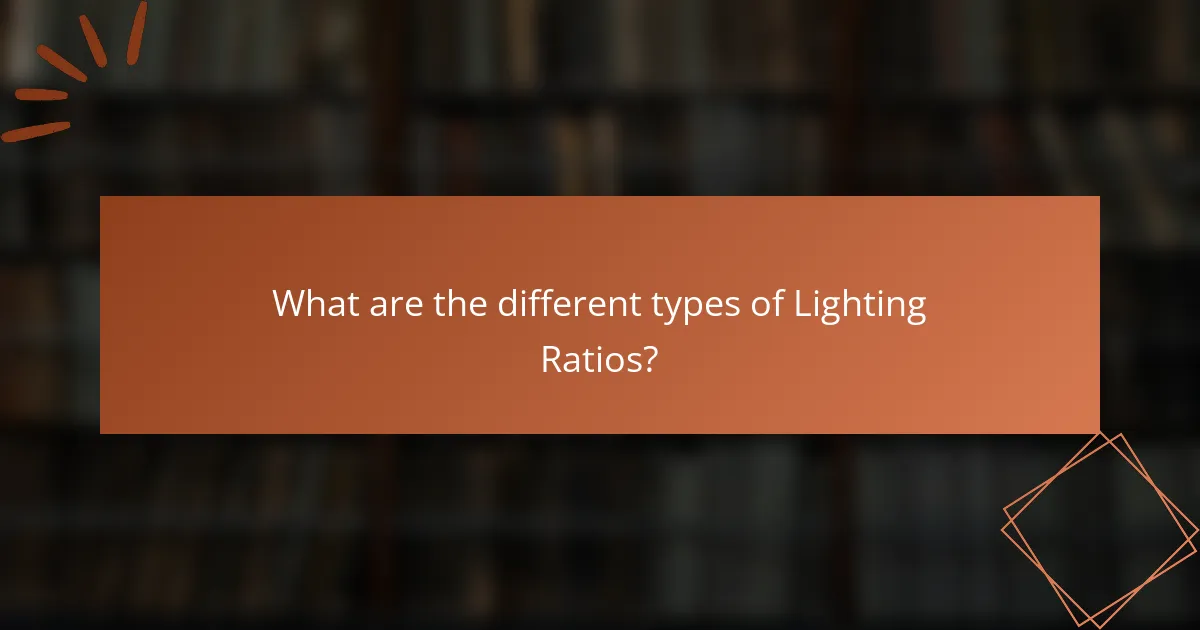
What are the different types of Lighting Ratios?
There are several types of lighting ratios used in photography. Common ratios include 1:1, 2:1, 3:1, and 4:1. A 1:1 ratio means equal lighting on both the subject and background. A 2:1 ratio indicates the subject is lit twice as brightly as the background. A 3:1 ratio creates a more dramatic effect, with the subject three times brighter than the background. A 4:1 ratio emphasizes shadows, providing high contrast in the image. These ratios help photographers control mood and depth in their work.
What is the difference between 1:1 and 2:1 Lighting Ratios?
1:1 lighting ratio means equal light intensity on the subject from multiple sources. This creates a flat, even lighting effect with minimal shadows. In contrast, a 2:1 lighting ratio indicates one light source is twice as bright as the other. This results in more pronounced shadows and highlights, adding depth and dimension to the subject. The difference impacts the mood and texture in photography. A 1:1 ratio is suitable for soft, even lighting, while a 2:1 ratio is ideal for dramatic effects.
How does a 3:1 Lighting Ratio impact image quality?
A 3:1 lighting ratio enhances image quality by creating a balanced contrast between highlights and shadows. This ratio means that the key light is three times brighter than the fill light. The result is a well-defined subject with depth and dimension. It avoids harsh shadows while still providing enough contrast to add visual interest. Photographers often use this ratio to achieve a natural look in portrait photography. Studies show that a balanced lighting ratio improves viewer engagement and focus on the subject. Therefore, a 3:1 lighting ratio is effective for producing professional-quality images.
What unique effects can be achieved with high Lighting Ratios?
High lighting ratios create dramatic contrasts in studio photography. They enhance the three-dimensionality of subjects. High ratios can emphasize textures and details in the image. This effect is particularly noticeable in portrait photography. Shadows become more pronounced, adding depth to the composition. High lighting ratios also allow for creative mood settings. For example, they can evoke a sense of mystery or tension. The use of high ratios can highlight specific features while diminishing others. This technique is commonly utilized in fashion and product photography to draw attention to key elements.
How can Lighting Ratios be manipulated for creative effects?
Lighting ratios can be manipulated for creative effects by adjusting the intensity of light sources. This can create dramatic shadows or highlights in photography. For instance, a higher ratio of key light to fill light results in more pronounced shadows. Conversely, a lower ratio softens shadows, producing a more even lighting effect.
Photographers often use these adjustments to evoke specific moods. A strong contrast can convey tension or drama, while softer lighting suggests calmness or intimacy.
Using light modifiers like softboxes or reflectors also influences lighting ratios. These tools can diffuse or redirect light, altering the overall effect.
Experimentation with different ratios allows photographers to discover unique visual styles. This flexibility is crucial in achieving desired artistic outcomes in studio photography.
What techniques can photographers use to achieve desired Lighting Ratios?
Photographers can achieve desired lighting ratios using various techniques. One method is adjusting the distance of the light source from the subject. Closer light sources create stronger illumination, altering the ratio. Another technique involves modifying the intensity of light through dimmers or filters. This allows precise control over the light output. Using reflectors can also help by bouncing light onto the subject, enhancing brightness without adding additional light sources. Additionally, photographers can employ multiple light sources with varying power levels. This setup enables the creation of specific lighting ratios tailored to the scene. Finally, utilizing softboxes or umbrellas can diffuse light, softening shadows and contributing to the overall ratio. These techniques collectively help in achieving the desired lighting ratios for effective studio photography.
How does modifying light sources influence Lighting Ratios?
Modifying light sources directly influences lighting ratios by altering the intensity and quality of light. Lighting ratios are determined by the relative brightness of different light sources in a scene. When a light source is modified, such as by changing its distance, diffusion, or color temperature, it affects the amount of light that reaches the subject. For example, moving a light closer increases its intensity, thus raising the lighting ratio. Conversely, adding diffusion softens the light, potentially lowering the ratio by reducing contrast. Studies show that optimal lighting ratios enhance the visual appeal of photographs. Adjusting light sources can create dramatic effects, emphasizing textures and shapes in the subject. Therefore, careful modification of light sources is crucial for achieving desired lighting ratios in studio photography.
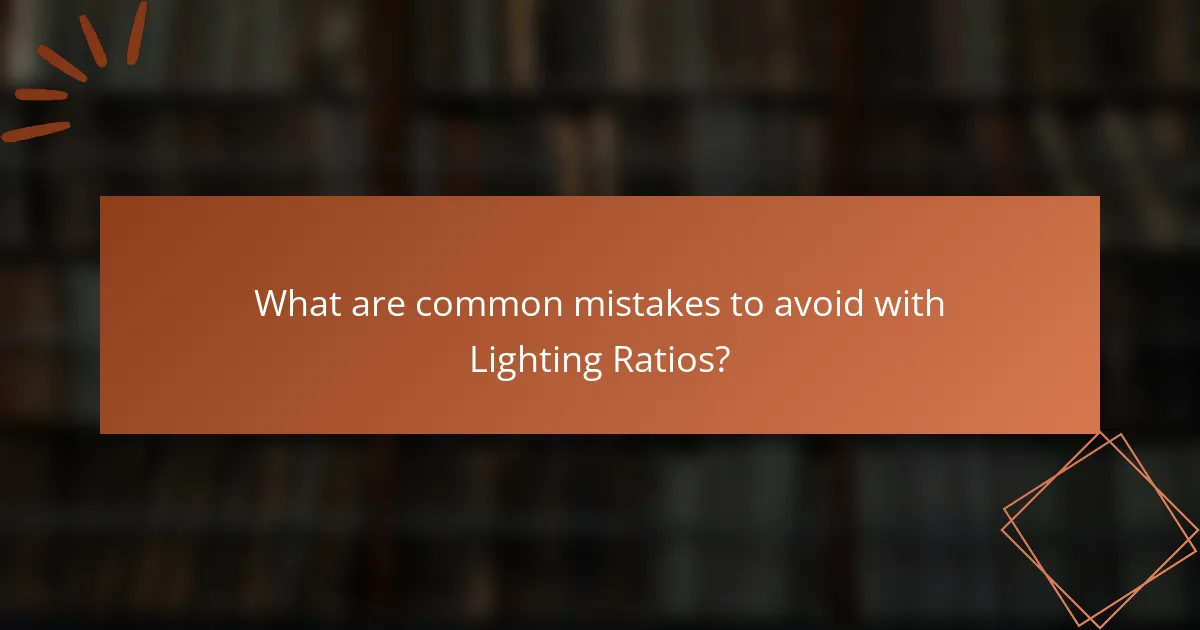
What are common mistakes to avoid with Lighting Ratios?
Common mistakes to avoid with lighting ratios include incorrect ratio settings. Many photographers fail to understand the importance of the subject’s distance to the light source. This can lead to uneven lighting and unflattering shadows. Overcomplicating lighting setups is another mistake. Simplicity often yields better results. Additionally, ignoring the background can detract from the overall composition. Not testing different ratios before shooting can result in missed opportunities for better images. Lastly, relying solely on auto settings can limit creative control over lighting ratios.
What errors do photographers often make when setting Lighting Ratios?
Photographers often make several errors when setting lighting ratios. One common mistake is not understanding the inverse square law. This law states that light intensity decreases with distance. Photographers sometimes position lights too far from the subject, resulting in inadequate exposure.
Another frequent error is failing to balance key and fill lights properly. This can lead to unflattering shadows or overly bright highlights. Photographers may also overlook the effect of ambient light. Ignoring ambient light can disrupt the intended lighting ratio.
Additionally, some photographers misjudge the power output of their lights. They may set one light too high or too low, causing uneven lighting. Lastly, not testing lighting setups before shooting is a common oversight. Testing allows photographers to adjust ratios for optimal results.
How can improper Lighting Ratios lead to unflattering images?
Improper lighting ratios can lead to unflattering images by creating harsh shadows or uneven highlights. When the key light is too strong compared to the fill light, it can result in excessive contrast. This excessive contrast can obscure [censured] features and create an unappealing look. Conversely, if the fill light is too strong, it can flatten the image and remove depth. Images lacking depth often appear dull and lifeless. A balanced lighting ratio is essential for achieving flattering portraits. Photographers often recommend a 2:1 or 3:1 ratio for optimal results. Studies show that well-balanced lighting enhances the subject’s features and overall appeal.
What are the signs of incorrect Lighting Ratios in photography?
Signs of incorrect lighting ratios in photography include harsh shadows and overexposed highlights. An imbalance in lighting can lead to loss of detail in both dark and bright areas. If the subject appears flat, it indicates insufficient contrast due to poor lighting ratios. Uneven skin tones or unnatural color casts also suggest incorrect ratios. Additionally, if the background is either too bright or too dark compared to the subject, it points to mismanaged lighting. These signs collectively indicate that the lighting ratios are not properly set for optimal photography.
What practical tips can improve your understanding of Lighting Ratios?
To improve your understanding of lighting ratios, practice adjusting light sources in controlled environments. Start with a basic one-light setup and gradually introduce additional lights. Use a light meter to measure and compare the intensity of each light. Familiarize yourself with common ratios, such as 1:1, 2:1, and 4:1. Experiment with different subjects to see how lighting ratios affect mood and depth. Analyze your results by reviewing photos and noting the effects of various ratios. Utilize online tutorials and resources to reinforce your learning. Engage with photography communities to share insights and gain feedback on your work.
How can practice and experimentation enhance skills with Lighting Ratios?
Practice and experimentation can significantly enhance skills with lighting ratios. Practicing different lighting setups allows photographers to understand how various ratios affect the mood and texture of an image. Experimentation with light sources helps in discovering unique effects that can be achieved through specific ratios. For instance, a 2:1 ratio can create a soft shadow, while a 4:1 ratio produces more dramatic contrasts. By adjusting the distance and intensity of lights, photographers can see real-time changes in their work. This hands-on approach leads to a deeper comprehension of lighting dynamics. As photographers refine their techniques, they develop a personal style that reflects their understanding of lighting ratios.
What resources are available for learning more about Lighting Ratios?
Books on photography often cover lighting ratios in detail. “Lighting for Digital Photography” by Scott Kelby explains practical applications. Online courses from platforms like Udemy and Skillshare provide structured learning. YouTube channels dedicated to photography offer free tutorials on lighting ratios. Websites like PetaPixel and Fstoppers regularly publish articles on lighting techniques. Forums such as Reddit’s r/photography facilitate discussions and sharing of resources. These resources collectively enhance understanding of lighting ratios in studio photography.
The main entity of the article is “Lighting Ratios in Studio Photography.” This article provides a detailed examination of lighting ratios, which define the relationship between key light and fill light, influencing shadow creation and the three-dimensionality of subjects. Key topics include the calculation and measurement of lighting ratios, their impact on mood and atmosphere, and the techniques photographers can use to manipulate these ratios for creative effects. Additionally, common mistakes and practical tips for improving understanding of lighting ratios are discussed, emphasizing their significance in achieving optimal image quality and aesthetic appeal.
